Long-term care
For this purpose, during 1915, the Auctioneers' and Estate Agents' Institute raised funds for the purchase of the old dilapidated Star and Garter Hotel on Richmond Hill, so that it could be converted into a home for the severely disabled ex-servicemen. The purchase price was nearly £20,000, while another £30,000 was spent on altering and equipping the Home.
While funds for the building of a more suitable residence were collected by the British Women's Hospital, a charity based at 21 Old Bond Street, the Star and Garter Home for Disabled Sailors and Soldiers opened on 14th January 1916.
The original hotel had been totally destroyed by fire in 1870, but an annexe built on a neighbouring site a few years before the fire had survived. The hotel had then been rebuilt on its original site in 1872. The Home occupied the low-roofed annexe and the ballroom of the hotel, while work continued on remodelling of the main structure of the pavilion building. It was anticipated that the Home would eventually have 264 beds. Some 50 totally disabled residents would be housed in one large ward, with 214 separate rooms for those not totally helpless.
The Home was managed by a Board of Governors appointed by the British Red Cross Society. The staff consisted of a Matron and 15 trained nurses, 19 nurses from the local Voluntary Aid Detachment and 3 from the British Red Cross Society. While the Home had a Resident Medical Officer, it was not a hospital.
The initial 64 patients were accommodated in two large wards on the ground floor - the annexe, which had been the hotel's dining room, and the Prince's Hall (the ballroom) which measured 80 feet (24 metres) by 61 feet (18.5 metres) and had a 33 feet (10 metres) high ceiling.
The patients were paralysed men who had been discharged from the services as incurable. If they showed signs of improvement they would be transferred to a hospital proper. Most had been shot through the spine or the brain and were paralysed below the waist. Being 'totally disabled', they were in receipt of the highest rate of pension - some 25 shillings (£1.25) a week. No deductions were made from this pension, nor were the patients charged while resident in the Home.
By June 1916 the Home was full. Sir Frederick Treves (1853-1923), Surgeon General to the King and Chairman of the Home's Board of Governors, who had taken a great interest in the project, supervised the care of the patients. They also received expert nursing care to relieve the bedsores and circulatory ailments cause by their permanent disability.
Of the 112 patients admitted during the first year. 28 were married and 84 single. The average age of the patients was 21 years, with the youngest being 17 years old and the oldest 47 years. The staff believed that there was no such thing as a hopeless case; therapy was provided to assist recovery as much as possible. The staff of 10 masseurs submitted each patient to persistent and continued treatment - massage, passive exercise and electrotherapy. By the end of the first year, although 20 patients had died, 18 had left the Home 'improved', and 5 were 'immensely improved', that is, they had been carried in but were able to walk out (one was married on the same day).
Handicrafts, such as needlework, embroidery, leatherwork and basketry, were introduced to provide occupation for the residents.
On 9th February 1917 the deeds of the property were presented to Queen Mary, who entrusted the building to the British Red Cross Society.
By October 1917 the Home had a waiting list and a new Annexe with 64 beds was opened. Some £10,000 of the cost of the building and its equipment was defrayed by the funds raised by the women of the Empire through the British Women's Hospital, while £40,000 was given for the endowment of the British Women's Ward and £10,000 for the permanent Compassionate Fund, which provided extra comforts for the residents and paid the expenses of visits by relatives, etc. In November 1917 a temporary Recreation Room was erected in the grounds.
Despite all the alterations made, the hotel building was found to be too small and generally unsuitable as a home for paraplegics. It was decided to demolish it and to build a purpose-built home. The British Women's Hospital Committee launched a worldwide appeal for funds and, with the help of the Navy League, the British Farmers' Red Cross Fund, the Meat and Allied Trades' Red Cross Fund and the United Province of India (War) Fund, soon raised enough money to rebuild the Home.
In 1919 Enbrook House in Sandgate, Kent, was purchased and converted at a cost of £42,000 for use as a seaside branch. On 23rd September 1920 the first patients arrived from Richmond. The seaside branch, with 40-50 beds, had 27 acres of grounds, where residents kept chickens and racing pigeons, and even donkeys, which were used to pull invalid carriages up the hill from the village. (The Sandgate branch closed in 1924 for rebuilding. It re-opened in January 1928 with 60 beds. With the fall of France imminent during WW2, the Board of Governors decided to evacuate the residents to safer accommodation at Richmond. The seaside branch finally closed on 28th May 1940)
The new Star and Garter Home for Disabled Sailors, Soldiers and Airmen was officially opened on 10th July 1924 by King George V and Queen Mary. The Home, which had an operating theatre and an X-ray Department, could accommodate 180 men and had been paid for mainly by the women of the British Empire, who adopted it as their war memorial.
By the mid 1930s the Home was offering accommodation to patients with other causes of nerve damage as well as injury. By 1935 a large number of cases of Parkinsonism following encephalitis lethargica were resident.
During WW2 more paralysed young men were admitted. Despite the fact that treatment for spinal injuries had not advanced significantly during the interwar years, a special paraplegic ward was set up for them under the direction of the German Jewish neurologist, Dr Ludwig Guttman (1899-1980), the founder of the spinal unit at Stoke Mandeville Hospital. Dr Guttman believed that sport was a method of therapy, as it helped to build physical strength and self-respect. In 1948 he instituted the Grand Festival of Paraplegic Sport, a precursor of the Paralympic Games. On 19th July 1948 he organised an archery competition to coincide with the opening ceremony of the London Olympic Games. Patients from the Star and Garter Home competed against those at Stoke Mandeville for a Challenge Shield. Following its success, the contest became an annual event, renamed the Stoke Mandeville Games, with more teams and more sports being subsequently added.
The Home did not join the NHS in 1948. It remained an independent institution run by the Star and Garter Charity, which had been established in 1922.
During the 1950s the residents were kept occupied in the Home's workshops. Activities included clock production, watch and clock repairs, sock making, rug making and toy production. Outings and entertainments were provided by the Lest We Forget and Not Forgotten Associations.
From 1971 the Home offered respite care. In 1979 it was renamed the Royal Star and Garter Home.
In 1986 ex-service women became eligible for admission.
On 26th June 1990 the Star and Garter Charity was granted a Royal Charter.
In 2008 eligibility for admission was extended to spouses, widows and widowers, and civil partners of ex-service personnel.
The Home currently has 60 residents.
Present status (May 2008)
In 1916 Sir Frederick Treves had stated that he hoped the new Home would be a "Hampton Court Palace for disabled soldiers". In 2008 plans were indeed made to move the Home to new premises on the site of the Jolly Boatman public house by Hampton Court station, opposite Hampton Court Palace. But the project floundered and was finally abandoned.
In 2011 a new site was purchased in Surbiton. Building work began in 2012 and the new premises are expected to be occupied by 2013, after which the Grade II listed Richmond Hill site will be sold.
The Royal Star and Garter Home is the only surviving spinal unit from WW1.
Update: November 2013
The Grade II listed building was sold for £50m in April 2013 to London Square, a housing developer.
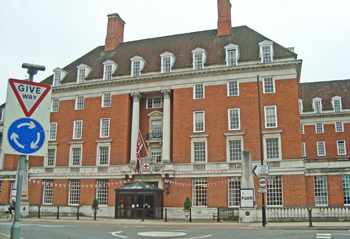
The main building on Richmond Hill was Grade II listed in 1990.
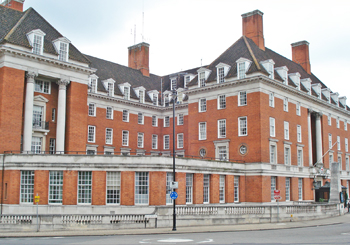
The Home from the south (above) and from the north (below).
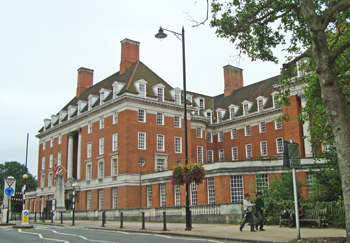
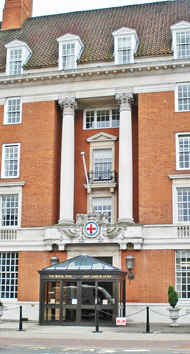
The main entrance.

Ancaster House, on the opposite side of the road, is also owned by the Home. Built in 1772, it was Grade II listed in 1950. It houses the Commandant's Lodge for the Royal Star and Garter Charity, while a neighbouring section facing Queens Road is leased for private residential use.
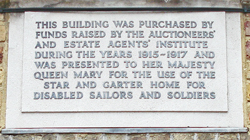
The stone plaque on the front of Ancaster House.
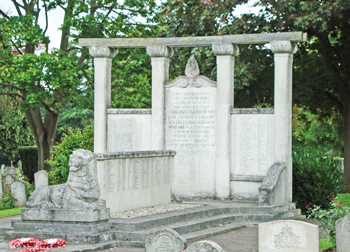
A Memorial to those who had died in the Home was unveiled in October 1957 in Richmond Cemetery. It was a gift from the Bromhead family and was dedicated to a former Governor, Lt Col .A.C. Bromhead C.B.E., J.P. and his wife, and to a former Matron and Governor, Mrs Margaret Bromhead.
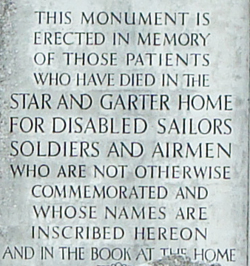
The inscription at the centre of the Memorial.
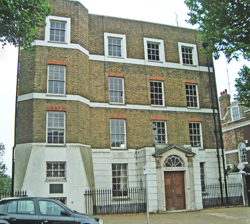
Wick House, the Nurses' Home, is to the north of the Home. Its Georgian facade has been much altered since it was built in 1772. The 4-storey building was Grade II listed in 1950.
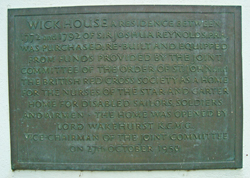
A plaque on the wall commemorates the opening of Wick House as a Nurses' Home in 1950. It reads: "Wick House, a residence between 1772 and 1792 of Sir Joshua Reynolds, P.R.A., was purchased, re-built and equipped from funds provided by the Joint Committee of the Order of St John and the British Red Cross Society as a home for the nurses of the Star and Garter Home for disabled sailors, soldiers and airmen. The home was opened by Lord Wakehurst, K.C.M.G., Vice-Chairman of the Joint Committee on 27th October, 1950."
The new Home, at the corner of Upper Brighton Road and Langley Avenue, Surbiton, opened in August 2013.
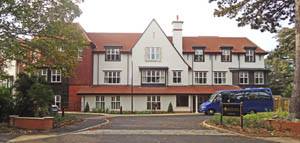
The frontage on Upper Brighton Road (above and below).

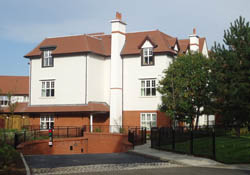
The building, as seen from Langley Avenue.
Update: November 2013
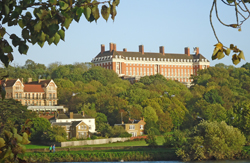
The Richmond building, as seen from St. Margaret's, Twickenham, across the River Thames.
(Author unstated) 1914 The Star and Garter Hostel. British Medical Journal 2 (11th Sept), 418.
(Author unstated) 1915 Care of the wounded. British Journal of Nursing, 14th August, 134.
(Author unstated) 1915 Care of the wounded. British Journal of Nursing, 23rd October, 337.
(Author unstated) 1916 Care of the wounded. British Journal of Nursing, 22nd January, 71.
(Author unstated) 1916 The British Red Cross. British Medical Journal 1 (2893), 834.
(Author unstated) 1917 Official news. The Red Cross 4, 29.
(Author unstated) 1917 The medical work of the Star and Garter in 1916. The Red Cross 4, 51-52.
(Author unstated) 1917 Our work. The Red Cross 4, 136.
(Author unstated) 1917 News in brief. The Red Cross 4, 141.
(Author unstated) 1924 The Star and Garter Home for Paralysed Men. British Medical Journal 2 (19 July), 119-120.
Cohen D 2001 The War Come Home. Disabled Veterans in Britain and Germany, 1914-1939. Berkeley, University of California Press.
Gowlland E 1935 Hyoscine in Parkinsonism. British Medical Journal 2 (2nd November), 877-878.
Silver JR 2011 Treves and the Royal Star and Garter Home (letter). Journal of the Royal Society of Medicine 104, 493.
Willis P 2006 The Home on the Hill: The Story of the Royal Star and Garter Home, Richmond. Richmond, Star and Garter Home.
http://en.wikipedia.org
www.britishlistedbuildings.co.uk
www.carehomesguide.com
www.defonseka.com
www.flickr.com (1)
www.flickr.com (2)
www.francisfrith.com
www.geograph.org.uk (1)
www.geograph.org.uk (2)
www.geograph.org.uk (3)
www.geograph.org.uk (4)
www.geograph.org.uk (5)
www.iwm.org.uk (1)
www.iwm.org.uk (2)
www.iwm.org.uk (3)
www.mandevillelegacy.org.uk
www.modoracle.com
www.nationalarchives.gov.uk
www.richmond.gov.uk (1)
www.richmond.gov.uk (2)
www.richmondandtwickenhamtimes.co.uk (1)
www.richmondandtwickenhamtimes.co.uk (2)
www.starandgarter.org (1)
www.starandgarter.org (2)
www.visitrichmond.co.uk
www.warfaremagazine.co.uk
Return to home page